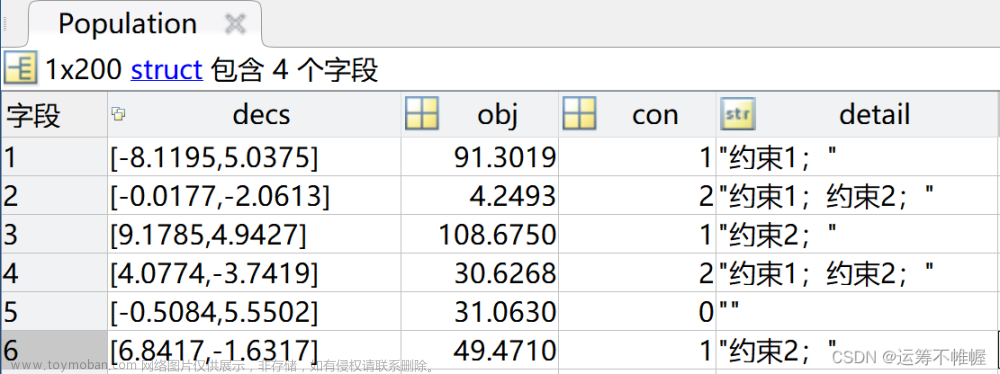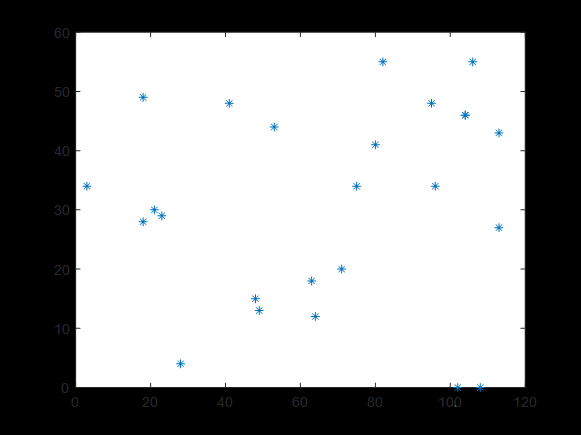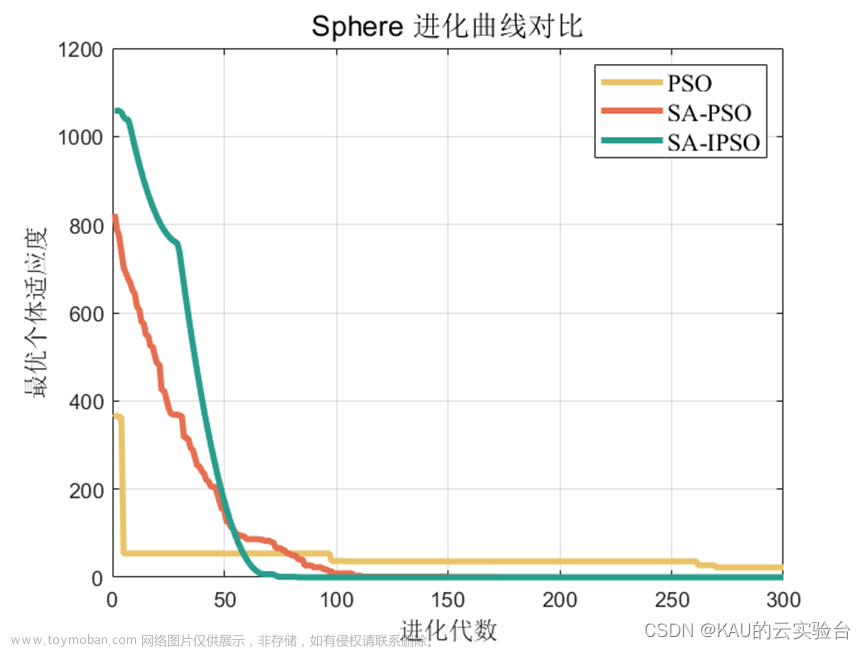一、模拟退火算法
模拟退火算法是一种全局优化算法,解决的问题通常是找到一个最小化(或最大化)某个函数的全局最优解。它通过模拟物理退火的过程来搜索解空间,在开始时以一定的温度随机生成初始解,然后一步步降低温度,同时在当前解的周围随机搜索新的解,并根据一定概率接受更差的解,从而有可能跳出局部最优解,最终得到全局最优解。
下面我们来看一个简单的示例,假设要求解目标函数 f(x,y)=sin(10x)+cos(3y)的全局最小值,取 −2≤x≤2,−1≤y≤1 作为搜索范围。我们可以使用以下代码来实现:
import math
import random
# 定义目标函数
def objective_function(x, y):
return math.sin(10*x) + math.cos(3*y)
# 定义模拟退火算法
def simulated_annealing(initial_temperature, cooling_rate, num_iterations):
# 设置初始解和初始温度
current_solution = [random.uniform(-2, 2), random.uniform(-1, 1)]
current_energy = objective_function(current_solution[0], current_solution[1])
current_temperature = initial_temperature
# 迭代固定次数
for i in range(num_iterations):
# 根据当前温度随机生成新的解
new_solution = [current_solution[0] + 0.1*random.uniform(-1, 1),
current_solution[1] + 0.1*random.uniform(-1, 1)]
new_energy = objective_function(new_solution[0], new_solution[1])
# 计算能量差
delta_energy = new_energy - current_energy
# 如果新解更优,则接受它
if delta_energy < 0:
current_solution = new_solution
current_energy = new_energy
# 否则以一定概率接受更差的解
else:
probability = math.exp(-delta_energy / current_temperature)
if random.uniform(0, 1) < probability:
current_solution = new_solution
current_energy = new_energy
# 降低温度
current_temperature *= cooling_rate
return current_solution, current_energy
# 设置初始温度、冷却速率和迭代次数
initial_temperature = 100
cooling_rate = 0.95
num_iterations = 1000
# 运行模拟退火算法
best_solution, best_energy = simulated_annealing(initial_temperature, cooling_rate, num_iterations)
# 输出结果
print("全局最优解:", best_solution)
print("全局最优值:", best_energy)
在这个示例中,我们使用了 objective_function 函数来定义目标函数。然后定义了 simulated_annealing 函数来实现模拟退火算法的核心部分,其中参数 initial_temperature 代表初始温度、cooling_rate 代表每迭代一次温度降低的比率、num_iterations 代表迭代次数。在 simulated_annealing 函数中,我们使用了当前温度和能量差来决定是否接受新的解,以及在新解较差时是否接受,这些都是模拟退火算法的核心步骤。
最后,我们设置了初始温度、冷却速率和迭代次数,并调用 simulated_annealing 函数运行模拟退火算法,得到了全局最优解和最优值,并将它们输出到控制台上。可以通过多次运行调整参数,得到更精确的结果。

二、遗传算法
如果有多个目标函数,可以使用多目标函数优化算法。其中一个比较常用的算法是 NSGA-II(Non-dominated Sorting Genetic Algorithm II),它是一种利用遗传算法求解多目标优化问题的算法。
NSGA-II 算法的核心思想是通过维护一个帕累托前沿面来寻找非支配解,然后对这些解进行选择和交叉操作,生成下一代种群。具体的步骤如下:
- 初始化种群,并计算每个个体的适应度值以及帕累托等级和拥挤距离。
- 进行帕累托排序,将种群中所有个体按照帕累托等级从小到大排序,相同等级的个体再按照拥挤距离从大到小排序。
- 选择一部分高质量的个体作为父代,并进行交叉和变异操作,生成下一代种群。
- 重复以上步骤,直到满足停止条件。
下面是一个使用 Python 实现 NSGA-II 算法解决多目标问题的示例代码:
import random
import copy
# 定义目标函数
def objective_function(population):
fitness = []
for x in population:
obj_1 = pow(x[0], 2)
obj_2 = pow(x[0]-2, 2) + pow(x[1], 2)
# 将两个目标函数值合并成一个列表
fitness.append([obj_1, obj_2])
return fitness
# 定义帕累托排序
def pareto_ranking(fitness):
n = len(fitness)
p = []
rank = [0] * n
S = [[] for i in range(n)]
F = [[] for i in range(n+1)]
for i in range(n):
S[i] = []
rank[i] = 0
for j in range(n):
if i != j:
if fitness[i][0] <= fitness[j][0] and fitness[i][1] <= fitness[j][1]:
if j not in S[i]:
S[i].append(j)
elif fitness[j][0] <= fitness[i][0] and fitness[j][1] <= fitness[i][1]:
rank[i] += 1
if rank[i] == 0:
F[0].append(i)
i = 0
while len(F[i]) > 0:
Q = []
for j in range(len(F[i])):
p_j = F[i][j]
for k in range(len(S[p_j])):
q = S[p_j][k]
rank[q] -= 1
if rank[q] == 0:
Q.append(q)
i += 1
F[i] = copy.deepcopy(Q)
del F[len(F)-1]
for f in F:
for x in f:
p.append(x)
return p
# 定义拥挤距离
def crowding_distance(fitness, indices):
n = len(indices)
distance = [0.0] * n
for m in range(2):
sorted_indices = sorted(indices, key=lambda x:fitness[x][m])
distance[sorted_indices[0]] = float('inf')
distance[sorted_indices[n-1]] = float('inf')
for i in range(1, n-1):
distance[sorted_indices[i]] += (fitness[sorted_indices[i+1]][m] - fitness[sorted_indices[i-1]][m])
return distance
# 定义选择操作
def selection(population, fitness, num_parents):
parents = []
n = len(population)
indices = [i for i in range(n)]
for i in range(num_parents):
front = pareto_ranking(fitness)
distance = crowding_distance(fitness, front)
max_distance_index = indices[front[distance.index(max(distance))]]
parents.append(population[max_distance_index])
indices.remove(max_distance_index)
return parents
# 定义交叉和变异操作
def crossover(parents, offspring_size):
offspring = []
for i in range(offspring_size):
parent_1 = random.choice(parents)
parent_2 = random.choice(parents)
child = [parent_1[j] if random.random() < 0.5 else parent_2[j]
for j in range(len(parent_1))]
offspring.append(child)
return offspring
def mutation(offspring_crossover):
for i in range(len(offspring_crossover)):
if random.random() < 0.1:
offspring_crossover[i][0] += random.uniform(-0.5, 0.5)
if random.random() < 0.1:
offspring_crossover[i][1] += random.uniform(-0.5, 0.5)
return offspring_crossover
# 设置算法参数
num_generations = 50
population_size = 100
num_parents = 20
offspring_size = population_size - num_parents
# 初始化种群
population = [[random.uniform(-5, 5), random.uniform(-5, 5)] for i in range(population_size)]
for i in range(num_generations):
# 计算适应度值和帕累托等级
fitness = objective_function(population)
# 选择操作
parents = selection(population, fitness, num_parents)
# 交叉操作
offspring_crossover = crossover(parents, offspring_size)
# 变异操作
offspring_mutation = mutation(offspring_crossover)
# 将父代和后代合并成一个种群
population = parents + offspring_mutation
# 输出当前最优解
best_individual_index = pareto_ranking(fitness)[0]
print("Generation ", i+1, ": Most optimal solution is ", population[best_individual_index])
# 输出所有 Pareto 最优解
pareto_front = pareto_ranking(fitness)
print("\nPareto front:")
for i in pareto_front:
print(population[i], objective_function([population[i]])[0])
在这个示例中,我们仍然使用 Python 来实现带有两个目标函数的多目标问题。首先定义了 objective_function 函数,它接收一个种群并返回每个个体的两个目标函数值。然后定义了 pareto_ranking 函数和 crowding_distance 函数来计算帕累托等级和拥挤距离。其中,pareto_ranking 函数用来对种群进行帕累托排序,得到每个个体的帕累托等级,crowding_distance 函数用来计算每个个体的拥挤距离。最后,定义了 selection 函数、crossover 函数和 mutation 函数来执行选择、交叉和变异操作,这些操作都是遗传算法的常见操作。

在主函数中,我们使用以上函数实现了 NSGA-II 算法,并使用种群的 Pareto 前沿面来输出所有的可行解。可以通过修改参数,例如种群大小、迭代次数等,来调整算法。
三、区别与联系
模拟退火算法(Simulated Annealing,SA)和 NSGA-II 遗传算法(Non-dominated Sorting Genetic Algorithm II)是两种不同的优化算法,它们具有以下几个区别:
算法思想不同
SA 算法是一种启发式随机搜索算法,基于模拟固体物质的退火过程,可以在接受劣解的概率下逐渐接近全局最优解。NSGA-II 算法是一种多目标遗传算法,主要针对多目标优化问题,通过维护帕累托前沿面来寻找非支配解。
应用场景不同
SA 算法适用于寻求单目标优化问题的全局最优解,尤其在搜索空间较小或者不存在明显的解析解时比较适用。NSGA-II 算法针对多目标优化问题,可以同时处理多个目标函数并生成 Pareto 前沿面上的一系列 Pareto 最优解。
优化方法不同
SA 算法通过改变温度来达到控制接受劣解的概率的目的,同时允许跳出局部最优解,从而在全局范围内搜索解空间。NSGA-II 算法主要通过选择、交叉和变异等操作来生成下一代种群,并通过帕累托排序来维护 Pareto 最优解。
算法复杂度不同
SA 算法的时间复杂度与温度下降速率有关,复杂度通常较低,但可能需要进行大量迭代才能收敛到全局最优解。NSGA-II 算法的时间复杂度主要受到种群大小、生成下一代种群的操作等因素的影响,通常情况下比 SA 算法更复杂。文章来源:https://www.toymoban.com/news/detail-432248.html
总的来说,模拟退火算法和 NSGA-II 遗传算法都是比较常见的优化算法,其适用的问题类型和搜索策略等方面有所不同,可以根据具体情况选择合适的算法。文章来源地址https://www.toymoban.com/news/detail-432248.html
到了这里,关于模拟退火算法与遗传算法求解多目标优化问题的算法实现(数学建模)的文章就介绍完了。如果您还想了解更多内容,请在右上角搜索TOY模板网以前的文章或继续浏览下面的相关文章,希望大家以后多多支持TOY模板网!












